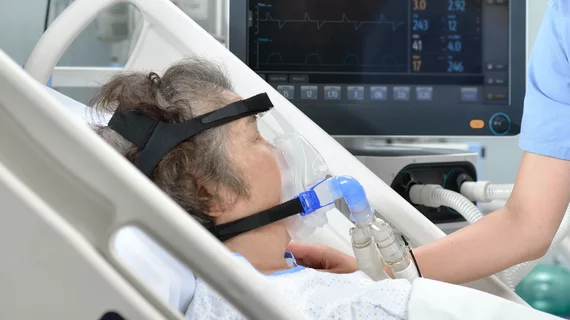With COVID cases surging, providers use POCUS to predict patients’ future hospital needs
Performing point-of-care-ultrasound early during COVID-19 patients’ hospitalization can help providers quickly determine if they will require intensive care, oxygen or other downstream needs.
Lung ultrasound abnormalities are more common in those who suffer severe coronavirus infection, but there’s been little research into whether scans ordered soon after admission can triage individual risk.
Stanford University experts determined POCUS findings spotted within 24 hours of admission can predict outcomes for a patient's entire hospital stay, the group reported Sept. 1 in the Journal of Ultrasound in Medicine. At the same time, none of the individuals with normal scans read within one day of their emergency department assessment were admitted to intensive care, required oxygen during their stay or were readmitted within 30 days.
As COVID-19 cases continue to mount and hospitals are again pushed to capacity, POCUS may become an indispensable tool.
“This information may substantially aid front-line providers in resource-limited settings experiencing patient surges,” Andre Kumar, MD, MEd, with Stanford’s Department of Medicine, and co-authors wrote. “In such scenarios, POCUS could augment admission or discharge decisions for providers. More broadly, POCUS could represent one of several tools to identify patients at-risk for adverse outcomes.”
The prospective study was carried out across four hospitals between March 2020 through January 2021. Overall, the cohort included 160 patients hospitalized with the virus who also underwent lung POCUS.
Kumar and co-authors found scans collected within 24 hours of patients’ emergency department evaluations predicted ICU admission, intubation, supplemental oxygen utilization and need for oxygen at discharge.
Aside from projecting future inpatient requirements, normal lung ultrasound results may reassure providers that COVID-19 patients will remain stable after discharge, the authors noted.
Some argue POCUS is limited by its need for an expert operator and complex scoring systems and protocols can help. But Kumar et al. suggest this only further restricts the modality.
“We disagree with such an approach and believe that the promise of POCUS lies in its simplicity and inherent expediency,” the authors added. “Importantly, our findings suggest that the high-risk features for COVID-19 are located primarily in the anterior or lateral lungs, which can be rapidly assessed by providers with limited POCUS experience.”

